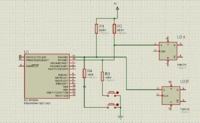pjmelect
Advanced Member level 2
The attached file contains a very simple Proteus circuit and program with a problem that has had me stumped for some time now. All the program does is write some data to a port and read it back in again in a loop checking the results. Every so often the wrong data is read from the port if any analogue component is connected to the port such as the virtual scope or a resistor. The program works correctly in hardware but not in Proteus. I am at a loss as to how to correct this as this is not a programming problem but a simulator bug. Any suggestions as to any settings in the simulator that may make my program run correctly?
